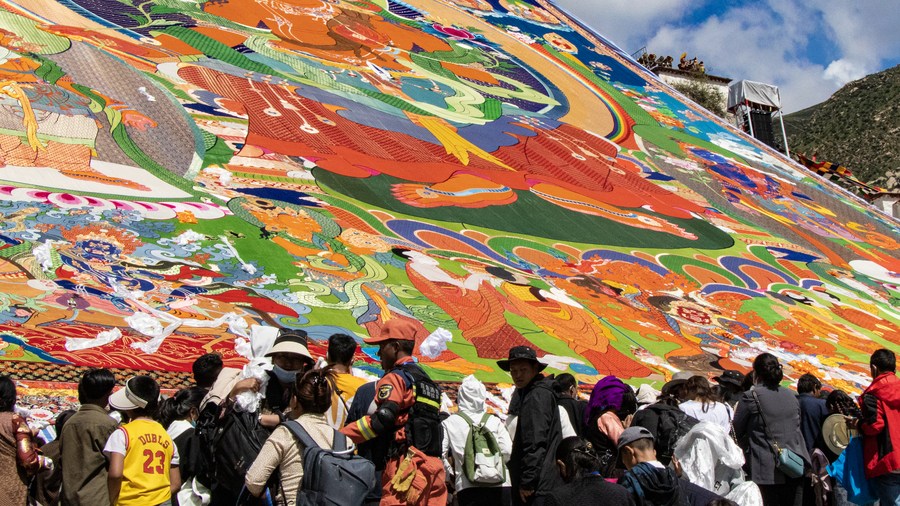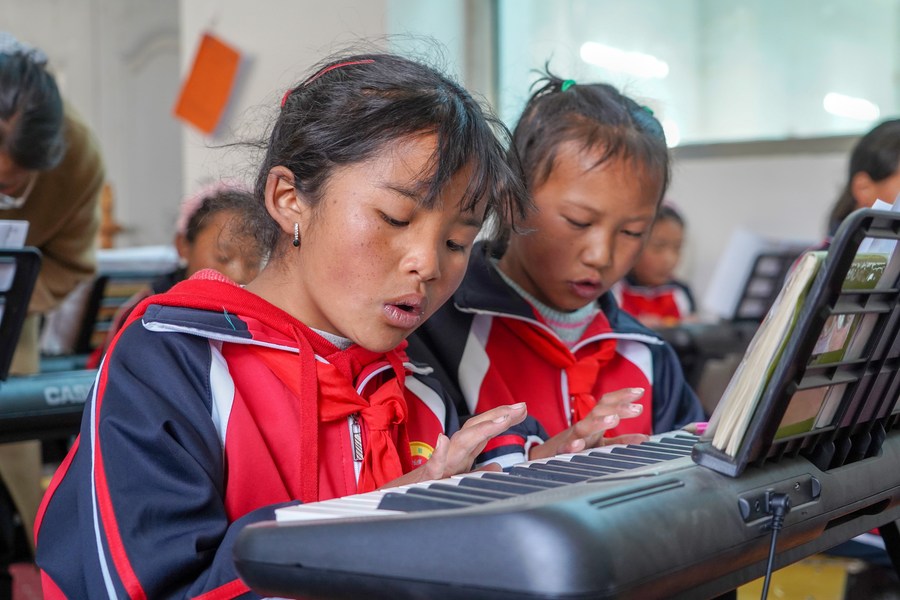Dynamic economic development in Xizang "impresses me the most", says Belarus ambassador

Believers and visitors look at a huge Thangka painting during the "sunning of the Buddha" ceremony at the Drepung Monastery in Lhasa, southwest China's Tibet Autonomous Region, Aug. 16, 2023. (Photo by He Bingjie/Xinhua)
"I believe that all the various examples above demonstrate the positive results of the implementation in Xizang of the people-centered development policy promoted by the Chinese government," she added.
GENEVA, Oct. 31 (Xinhua) -- China's Xizang Autonomous Region is a unique place with a rich history and unique cultural heritage, but what impressed the permanent representative of Belarus to the United Nations Office in Geneva most was its dynamic economic development.
Ambassador Larysa Belskaya recently visited the region with a group of diplomats.
"While traveling, we saw active construction of roads and bridges, houses and infrastructure. I was very impressed by the mountain slopes dotted with endless power lines and transmission towers," she said.
After visiting an ordinary family in the Xiga village, Belskaya said it was "a good illustration of China's policy of eradicating poverty through targeted assistance and development on the ground."
The family is part of a community that was resettled a few years ago from a hard-to-reach mountainous area. Like other families, they were provided with comfortable accommodation and financial support.
"The family now has a good income, a cozy house and vegetable garden, and they have no problems with drinking water, electricity or medical care," the ambassador said.
Another "impressive and emotional example" she mentioned is the Xizang Care Center for the Disabled in Lhasa. The center works with the support of the state, local authorities and philanthropists to provide sick children from the most disadvantaged families with hospital treatment and physical rehabilitation.
"We have watched how teenagers with disabilities play basketball, showing good physical training and cheering each good throw. This was a vivid example of how systematic professional care and humane attitudes help to make life more joyful even for children in wheelchairs," she said.
"I believe that all the various examples above demonstrate the positive results of the implementation in Xizang of the people-centered development policy promoted by the Chinese government," she added.

Monks carry a huge Thangka painting at the Drepung Monastery in Lhasa, southwest China's Xizang Autonomous Region, Aug. 16, 2023. (Photo by Tenzin Nyida/Xinhua)
During their tour of Xizang, she saw many people in temples and monasteries freely praying and worshiping Buddhist shrines, which made her believe that the religious traditions of Tibetans are respected, she said.
"I had the opportunity to visit the Sera Monastery, Jokhang Church and Potala Palace. The clergy with whom I spoke emphasized that the state provides great assistance in the renovation of religious buildings, restoration of unique paintings and architecture," she said.
Belskaya and senior diplomats from other countries also visited several schools, and attended classes on Tibetan language, traditional writing and calligraphy, music and singing, which are part of the school curriculum along with the Chinese language.
"We have seen in the Primary School of Nyingchi and the Middle School of Lhasa, that children from different ethnic minorities could wear both uniforms and national costumes. We also were given the opportunity to see wonderful musical performances based on Tibetan folk opera performed by students in beautiful traditional costumes and masks," Belskaya said.
She added that she was impressed with the Museum of Cultural Heritage of Southeast Xizang in Nyingchi, which presents a collection of Tibetan people's costumes and style of dress, textiles, pottery, tools, objects of everyday life, arts and handicrafts.
"The Museum displays provide an important insight into the history and culture of the region," she said, adding that all these impressions allow her to say that the rich mosaic of Tibetan culture and spiritual traditions is respected, maintained and developed.

Pupils attend a piano class at a primary school of Zhaxizom Township in Tingri County, Xigaze City, southwest China's Xizang Autonomous Region, June 5, 2023. (Xinhua/Shao Zedong)
She was also very impressed by a boarding middle school, where the computer classes were well-equipped to teach students the basics of information and communication technology, and even of artificial intelligence.
"I know that some countries criticize China for boarding schools, I don't think that's fair. It must be taken into account that Xizang is a highland region with a highly dispersed population in many areas. Boarding schools help children from agricultural and pastoral areas to attend school, and provide sufficient Tibetan language teachers. It is a practical way to ensure that all children in Xizang have an equal right to education," she said.
- Interview: China's economic development drives global growth, says Egyptian expert
- Nepalese tea debuts in China's Xizang via land port
- Facts show human rights in China's Xinjiang and Xizang well-protected: Kenyan expert
- China's Xizang reports robust foreign trade growth in 2023
- Land ports in China's Xizang see growing imports and exports

